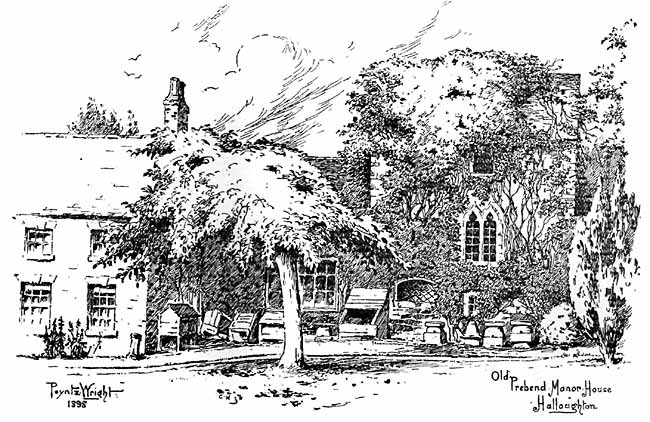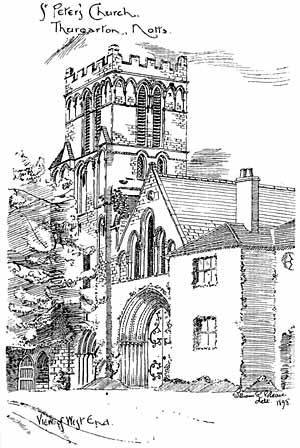The party then re-entered the brakes and continued their journey. At Halloughton Mr. Baylay was once more the guide, and he was able to give the party many interesting details. From the pulpit of the church he pointed out all the objects of interest in the building.
He said that the great size of the chancel relatively to the nave might be due to the fact that even when the 13th century church was built Halloughton was the seat of a prebendary of Southwell. The original chancel arch, no doubt a narrow one, was removed, probably in the 15th century, when the rood screen was introduced, as was often done. A few years ago most of the church, with the exception of the east wall, was taken down and re-erected, and though the old windows were preserved, their positions were very much altered. The screen was a beautiful specimen of 15th century woodwork. The enormous extent of churchyard was striking in a parish where the population had always been so small.
 The Old Prebend Manor House, Halloughton by Poyntz Wright (1898).
The Old Prebend Manor House, Halloughton by Poyntz Wright (1898).Before re-entering the conveyances Mr. Baylay conducted the party across the highway to the old manor house. Members of the society, he remarked, had probably read in guide books a very wonderful and gruesome account of a nunnery at Halloughton connected with Thurgarton Priory and the evil doings thereof. But there had never been a religious house of any kind at Halloughton, nor was there any connection between Thurgarton Priory and Halloughton, the latter place having become the property of a Prebend in Southwell Minster a long time before the priory at Thurgarton was founded. As to the supposed subterranean passage, all he would say was that if anyone, having carefully surveyed the ground between that place and Thurgarton, still believed in the possibility of an underground passage between the two places, he should not try to disturb his belief. But there were at that spot the remains of the manor house belonging to the Prebend of Halloughton. The principal surviving building might be described as a low stone tower, of which the basement formed a storeplace, and above that a pleasant chamber facing south, with one more room at the top. It was of the latter part of the 14th century. He took it that the tower was an addition to the then manor house. The Prebend of Halloughton was known as the lay Prebend, because its endowment consisted of a manor, and not of the tithes of any church, except those of Halloughton itself.
The visit to the village terminated with an inspection of the medieval dovecote.

View of the west end of Thurgarton Priory by William R Gleave (1898).
At Thurgarton Priory Mr. Baylay again acted as guide, and make the following remarks:—
The Priory of Thurgarton was founded by Ralph D’Eyncourt in 1187, but no buildings of that date were now standing there, although some carved stones might be seen in the Priory garden which formed part of them. The D’Eyncourts were said to have inhabited a castle on the spot in the village called Castle Hill. Like most of the houses of Augustinian canons, or “ black canons,” as they were commonly called in England, the priory was founded in the parish church of Thurgarton, but in course of time their possessions included the entire parish, besides much land elsewhere, and as the whole population were practically the servants of the convent, it would seem that a parish vicar ceased to be appointed for Thurgarton, and the canons themselves ministered to the people of the parish. The portion of the conventual church now remaining was of the 13th century, and consisted of the three westernmost bays of the nave with one of the two west towers. It was originally of great size, not falling far short of the minster at Southwell. After the dissolution the buildings served as a quarry for the neighbourhood. Its wrought and carved stones were to be found all over the place. To serve as a parish church there were left the three bays of the nave, converted into an oblong room by walling up the arches and removing the triforium and clerestory. In 1854 the church was restored and brought to its present form. Outside the noble and peculiar character of the Early English tower and the traces of the original west windows deserved special notice. The height of the original wall of the church was well marked by the rough stones projecting from the tower and by the rude stone gargoyle. The west doorway was a fine specimen of an undivided Early English door. When that front had both its towers, its three portals, and lofty gable, it must have been peculiarly striking and impressive. Referring specially to the Priory, the domestic buildings of the Priory seemed to have been speedily destroyed after the dissolution, with the exception of the kitchen. In their place a gabled stone house was constructed, standing on the foundations of the building ranging along the west side of the cloister, joining at the northern end on to ruins of the southwest tower of the church. That stone house was, in its turn, destroyed about 100 years ago, and replaced by the present house of brick, standing on the same foundations, or nearly so. In 1854 Mr. Milward, when restoring the church, also extended the house northwards so as to join on to the church, and made a door of communication.
The party then went through the house and down into the crypt, which Mr. Baylay said he believed had been intended for use as a storehouse, and before leaving remarked that Newstead, a house of the same order, exhibited a very instructive parallel arrangement to Thurgarton.
